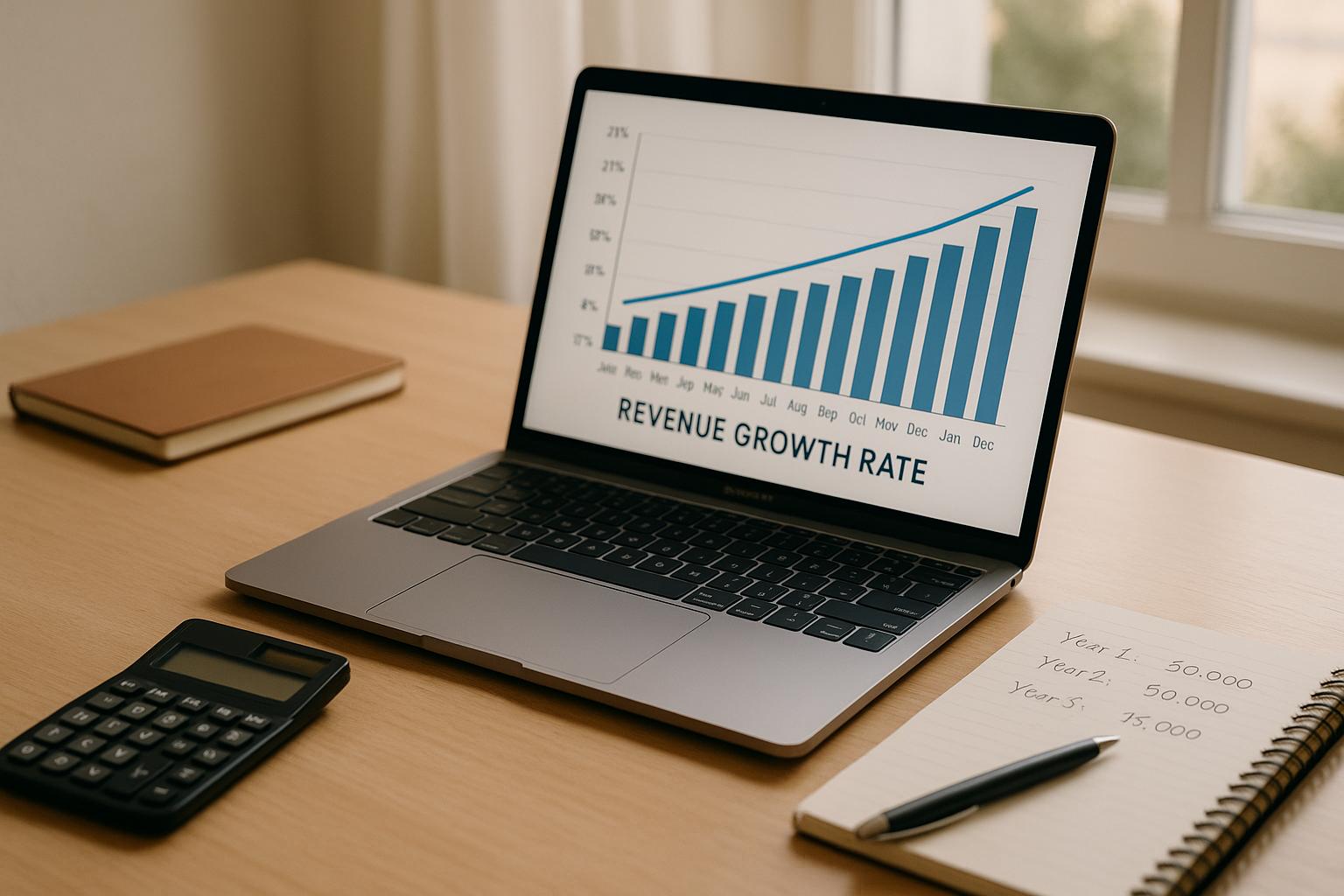How Market Comparables Help Value Private Companies

Market comparables are a practical way to estimate the value of private companies by comparing them to similar public companies. This method uses financial ratios like P/E, EV/EBITDA, and P/S to provide benchmarks for valuation. Here's what you need to know:
-
Why Use Market Comparables?
They help in raising funds, planning growth, and making M&A decisions by aligning private company valuations with industry norms. -
Challenges:
- Limited data on private companies
- Liquidity constraints
- Different accounting practices
-
How to Choose Comparables:
Focus on similar business models, size, growth stage, and geography. Tools like NAICS, GICS, and platforms like PitchBook can help. -
Adjustments for Private Companies:
Apply discounts (20-40%) to account for lower liquidity and marketability. -
Key Tools:
Platforms like PitchBook, PrivCo, and S&P Global provide private company data, while advisory firms refine the process.
Market comparables are most effective when combined with other valuation methods like DCF and expert advice.
Selecting Comparable Companies
Finding the right comparable companies is a key step in accurately valuing a private company. It involves evaluating several factors to ensure the comparisons provide insights that align with market conditions.
Key Factors for Choosing Comparables
When selecting comparable companies, focus on these core attributes:
- Business Model: Look for companies in the same industry, dealing with similar market dynamics and regulations.
- Size: Choose companies with revenue and market capitalization within 20% of the target company.
- Growth Stage: Match companies at similar stages of development - whether startups or established businesses, as their metrics can vary widely.
- Geographic Presence: Compare companies operating in the same regions to account for local economic influences.
Industry classification systems like NAICS and GICS are helpful tools for identifying companies in the same sector.
Steps for Finding Comparables
- Initial Screening: Start by identifying companies in the same industry and size range. Use tools like NAICS or GICS, along with platforms like Bloomberg or Thomson Reuters, to narrow down the options.
- Detailed Analysis: Dive deeper by analyzing factors such as revenue breakdown, profit margins, capital structure, and customer base.
- Refinement: Compare business models and operational metrics, ensuring the selected companies are true peers. Adjust for any unique characteristics of the target company.
For instance, comparing a large corporation to a small startup can lead to distorted results due to size differences.
Advisory firms, like Phoenix Strategy Group, provide specialized data and expertise to simplify this process, helping ensure the selected comparables reflect current market trends.
After identifying the right comparables, the next step involves applying valuation multiples to extract actionable insights.
Applying Valuation Multiples to Private Companies
Once you've identified comparable companies, the next step is to use valuation multiples to estimate a private company's value.
Types of Valuation Multiples
Valuation multiples help compare private companies to their peers. Here are three commonly used multiples and their typical applications:
| Multiple Type | Description | Common Usage |
|---|---|---|
| EV/Revenue | Enterprise Value to Revenue ratio | Best for early-stage or high-growth industries |
| EV/EBITDA | Enterprise Value to EBITDA ratio | Ideal for mature companies, especially in manufacturing |
| P/E (Price/Earnings) | Price to Earnings ratio | Suited for profitable, well-established firms |
Industry-Specific Valuation Multiples
Different industries favor different valuation approaches. For example, technology companies often see higher revenue multiples due to their scalability, while real estate firms lean on EV/EBITDA to account for depreciation and amortization.
Adjusting Multiples for Private Companies
Private companies typically require adjustments to their valuation multiples. A discount of 20-40% is common to reflect liquidity constraints compared to public firms. On the other hand, controlling interests may add a premium due to the added benefits of decision-making authority.
For fast-growing private businesses, higher multiples can sometimes be justified. However, this should be weighed against risks like execution challenges and changing market conditions.
Accurate valuation is a mix of hard numbers and professional judgment. You'll need to consider factors like financial trends, competitive standing, and the quality of management. Once you've adjusted the multiples, the next priority is gathering reliable data for precise comparisons.
Sources of Data for Market Comparables
Private Company Data Platforms
Private company data platforms are essential tools for comparing businesses and assessing valuations. They provide access to detailed information about companies, helping users identify peers and calculate valuation multiples.
| Platform | Key Features | Coverage |
|---|---|---|
| PitchBook | Financing history, detailed financials, M&A data | Over 3 million private companies |
| PrivCo | Financial health metrics, deal terms, market position | 400,000+ U.S. companies |
| S&P Global | Financial statements, valuation data, market analysis | 15 million+ global companies |
Market Research and Advisory Services
Market research reports and advisory services offer additional insights that complement platform data. For example, IBISWorld provides industry-specific information such as market size, growth rates, and competitive landscape details, which help refine valuation multiples. Trade publications and industry associations also deliver sector-specific benchmarks and insights.
Advisory firms play a key role in validating and improving comparable analysis. AlphaSense, trusted by 85% of S&P 100 companies, grants access to over 10,000 sources of private, public, and premium content, enhancing the depth of company comparisons.
For accurate valuation analysis, it's crucial to use a mix of data sources and verify the information through cross-checking and expert consultation. While these resources are invaluable, understanding their limitations is necessary to ensure precise results.
sbb-itb-e766981
Limitations of Using Market Comparables
Market comparables can offer helpful insights, but applying them to private companies comes with challenges that require a closer look.
Data Quality and Availability
Private companies often lack the transparency of public firms, making it harder to gather reliable data for valuations. Platforms like PitchBook and PrivCo can help, but their data may be incomplete or outdated compared to the detailed disclosures available for public companies.
Differences in Accounting Practices
Accounting methods differ significantly between public and private companies, creating challenges for accurate comparisons. Public companies follow strict standards like GAAP or IFRS, while private firms often use more flexible accounting approaches.
| Accounting Aspect | Public Companies | Private Companies | Impact on Valuation |
|---|---|---|---|
| Revenue Recognition | Adheres to GAAP/IFRS rules | May rely on cash-basis accounting | Alters growth metrics |
| Expense Classification | Standardized categories | Varies widely | Skews profit margins |
| Asset Valuation | Regular mark-to-market | Often uses historical cost basis | Impacts balance sheet ratios |
Influence of Market Conditions
Valuation multiples are highly sensitive to market conditions, especially during periods of economic uncertainty. For example, Phoenix Capital Group saw its valuation jump from $20 million in 2019 to nearly $300 million by 2022, largely due to favorable market timing. To account for such variability, valuators often apply a liquidity discount - typically around 30% - to reflect the reduced marketability of private companies.
Even with these challenges, market comparables can still be a useful tool when paired with other valuation methods and expert analysis.
Conclusion: Using Market Comparables for Business Growth
Market comparables, when paired with other valuation methods and expert advice, can be a valuable tool despite their limitations.
Key Takeaways
Market comparables are a useful approach for valuing private companies, but they require careful consideration. Success hinges on selecting comparable companies that align in terms of industry, size, growth rate, and profitability. For the best results, these comparisons should be combined with other methods, like discounted cash flow (DCF), to improve accuracy.
With precise valuations, businesses can make informed decisions - whether it's about securing funding, expanding operations, or planning an exit. The true potential of market comparables is unlocked when paired with expert analysis and insights tailored to the specific industry.
How Advisory Firms Add Value
Advisory firms play a critical role in improving valuation accuracy. Their proprietary data and expertise help address challenges unique to specific industries. For example, firms like Phoenix Strategy Group provide insights that align valuations with market conditions and strategic objectives.
When data gaps make valuations tricky, advisory firms can step in to:
- Provide access to reliable comparable company data
- Adjust valuations to reflect unique company factors
- Integrate market comparables with other valuation techniques
- Develop actionable strategies for growth and exit planning
"The combination of market comparables with other valuation methods like DCF provides a more comprehensive valuation approach", says David Metzler of Phoenix Strategy Group. "This multi-faceted strategy helps businesses make more informed decisions about their growth trajectory and potential exit opportunities."
FAQs
Can you use public comps to value a private company?
Yes, public comps are often used to estimate the value of private companies, especially when detailed financial data is unavailable. However, adjustments for factors like company size, market position, and growth rates are critical to ensure accuracy.
How can you determine a private company's value?
Valuing private companies typically involves combining methods like Discounted Cash Flow (DCF) and Comparable Company Analysis (CCA). Factors such as financial performance, industry trends, and market conditions play a key role in arriving at a fair valuation.
What are the best sources for private company information?
Accurate private company data comes from a mix of sources, including research platforms, industry reports, and professional advisory services. While each source offers specific insights, combining multiple data points with expert analysis provides a more complete picture.
How do I find a private company's valuation?
To value a private company, a structured approach using DCF and CCA methods is essential. Adjustments should be made for financial performance, growth potential, and market trends. Partnering with advisory firms that leverage proprietary databases and industry expertise can help ensure precise and relevant valuations.
Effectively addressing these valuation challenges allows businesses to better utilize market comparables and make informed decisions for growth and strategy. Combining different valuation methods while considering the unique traits of private companies is key.




